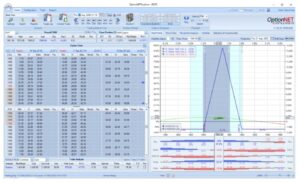
THJ Systems Limited & Anor v Daniel Sheridan & Anor [2023] EWCA Civ 1354 concerned many issues but the one of most interesting was the correct legal test to consider whether a copyright work is original. One would think this has been well rehearsed in numerous cases already, but the Court of Appeal decision demonstrates the English courts are still applying pre-Brexit CJEU law given at this point that law remains effective.
The case was about the breakdown in a commercial relationship between Andrew Mitchell, a UK based software developer, and Daniel Sheridan, a US options trading mentor. Mr Mitchell and Mr Sheridan had formerly entered into a joint business venture, OptionNet LLP (the second claimant in the appeal). The venture concerned software, known as OptionNET Explorer, developed by Mr Mitchell and used by Mr Sheridan and his company Sheridan Options Mentoring Corporation in his mentoring business.
The main issue in the proceedings before the High Court at first instance was whether Mr Mitchell had validly expelled Mr Sheridan from OptionNet. However, the High Court had also considered (1) whether THJ Systems Limited (the first Claimant in the appeal) had validly terminated Mr Sheridan’s’ licence to use the software, and (2) THJ’s claims that Mr Sheridan’s alleged use of the software after such termination infringed THJ’s copyright works relating to it. While the judge had held that copyright subsisted in these works, he dismissed the claims for copyright infringement on grounds that no infringement had been proved.
Both sides appealed to the Court of Appeal. Mr Sheridan appealed the judge’s declaration that “[t]he graphic user interface, the graphic displays produced by the Software when in use, and the ONE logo … are artistic works: a. in which copyright subsists; b. of which Andrew Mitchell is the author; and c. of which THJ is the owner”. Mr Mitchell, THJ and OptionNet cross-appealed against the judge’s dismissal of their claim for copyright infringement.
Although the claims before the judge concerned both copyright in the software as a literary work and copyright in graphical displays produced by the software (the GUIs) as artistic works, the appeals only concerned the GUIs. In that regard, the claimants had relied on copyright in “risk and price charts” produced by the software, which they asserted were graphic works within the meaning of section 4(1)(a) CDPA 1988. An example of one of these charts is shown below.

Mr Sheridan disputed that these charts were sufficiently original to merit copyright protection. The judge had reasoned that he was satisfied that “the work of creating the look and functionality of interface including the arrangements of the tables and graphs did involve the exercise of sufficient skill and labour for the result to amount to an artistic work”. In the appeal, Mr Sheridan contended that this was not the correct test to apply.
Giving the leading judgment in the Court of Appeal, Lord Justice Arnold agreed with Mr Sheridan. The test of “skill and labour” was the test of originality that the UK courts had applied prior to the EU Court of Justice’s seminal ruling in Infopaq, following which the test to be applied is whether the work is “the author’s own intellectual creation”, which is a more demanding test. Arnold LJ therefore proceeded to apply the correct test. In doing so, he made the following observations:
- The various component parts of the risk and price charts had been laid out with some care;
- Quite a large amount of information was crammed into the GUI;
- Mr Mitchell had made choices as to what to put where, including which commands to put in the ribbon feature and in what order;
- Mr Mitchell had also selected what fonts and colours to use;
- Mr Mitchell’s evidence that “the look and feel of it is my brainchild” was unchallenged;
- While Mr Mitchell had sourced the component parts from a library, he had put them into various locations, arranging and configuring them;
- While the degree of visual creativity in the risk and price charts was low, there could still be copyright (even if it was correspondingly narrow so that only a close copy would infringe).
Arnold LJ concluded by stating that even though the judge had applied the wrong test, he was correct to find the risk and price charts were original. Arnold LJ also allowed Mr Mitchell, THJ Systems and OptionNet’s cross-appeal on an altogether more technical line of argument. Essentially, Mr Sheridan and his company had previously accepted that if the claimants could successfully prove ownership of copyright, then infringement was admitted. Mr Mitchell and the other claimants had relied upon that.
Historically, the courts in the UK have adopted a ‘low’ standard of originality for copyright subsistence and this case is a further illustration of that approach, even taking into account the slightly sterner test of ‘intellectual creation’ derived from Infopag. Although it did not concern a purely computer generated work (i.e. with no human author as anticipated by section 9(3) CDPA), it does illustrate that a relatively modest human contribution can give rise to the necessary degree of creativity for copyright to subsist.
_____________________________
To make sure you do not miss out on regular updates from the Kluwer Copyright Blog, please subscribe here.
Kluwer IP Law
The 2022 Future Ready Lawyer survey showed that 79% of lawyers think that the importance of legal technology will increase for next year. With Kluwer IP Law you can navigate the increasingly global practice of IP law with specialized, local and cross-border information and tools from every preferred location. Are you, as an IP professional, ready for the future?
Learn how Kluwer IP Law can support you.


